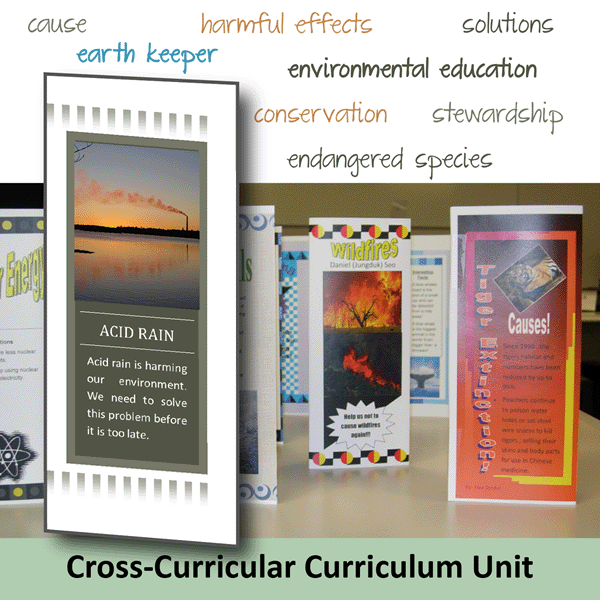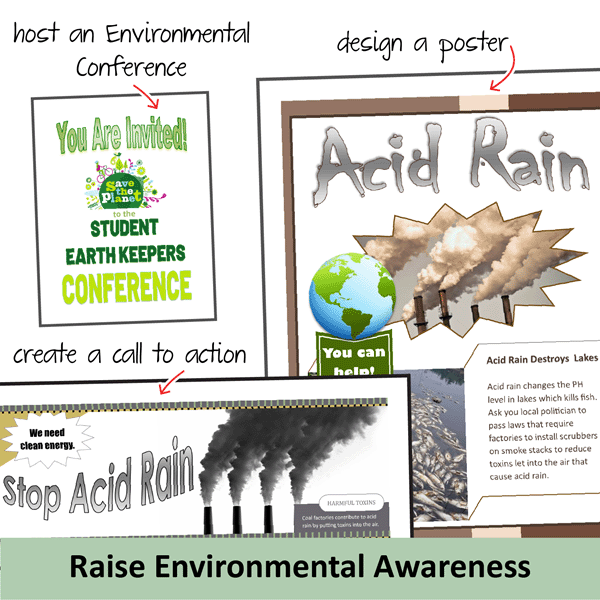Description
Environmental Lesson Plans for Middle and High School
In this project, students aged 11-18 become Earth Keepers. They raise environmental awareness about a current issue. To start, they use the Internet to research facts and organize information under headings in a Microsoft Word document. Next, they learn how to use the tools in Microsoft Publisher to craft a creative postcard and poster as a call to action. To inform people further about the importance of this issue, students produce a pamphlet that describes the harmful effects and proposes solutions. Optional activities have students prepare for an Environmental Conference by creating a calendar, banners, and invitation to the event.
Raise Environmental Awareness
This cross-curricular curriculum unit for Grades 6-12 integrates seamlessly into geography, science, or social studies. Dive into topics like conservation, endangered species, or natural resources. By creating a series of publications, students explore the connection been human activity and the natural world. They summarize information about the cause, harmful effects, and solutions to a problem. This investigation fosters an understanding of the importance of stewardship and sustainability.
Environmental Education Fact Cards
Environmental lesson plans includes 15 fact cards to help students with research. Topics include acid rain, clear cutting, endangered reefs, fuel emissions, garbage, global warming, invasive species, kudzu invasion, mining, nuclear energy, oil sands, over-fishing, plastic pollution, poaching, and water consumption. These easy-to-understand resources support learners and make research a breeze.
Project Based Learning Course for Environmental Education
No risk of plagiarism! Students transform their knowledge into a unique call to action. Step-by-step instructions explain how to use Publisher to create postcards, posters, and pamphlets to inform others about an environmental issue.
Become an Earth Keeper
TechnoEnvironment includes a curriculum guide with teaching strategies and helpful tips, as well as resource files to reinforce learning. Minimize classroom preparation using the provided lesson plans, example files, templates, environmental fact cards, quizzes, checklists, and marking sheets.
The TechnoEnvironment course has 14 assignments divided into six sessions.
Session 1: Research the Topic
Students research an environmental issue. To start, they learn about the importance of stewardship. Next, they select a topic and then design an outline in Microsoft Word with headings to organize facts. The Internet is used to locate information about the issue, including effects on the environment and solutions to the problem. Students record the source and gather pictures related to the topic. This research will provide the content for the publications they create in the following sessions.
Session 2: Postcards from the Edge
Students send a postcard to a friend asking them to become involved in protecting Earth. To prepare for this task, they are introduced to Microsoft Publisher. Once familiar with the parts of the window, a template is opened in the program. Students learn how to draw and format a shape to create a background for the front of the postcard. Next, they include a catchy title using a text box. To attract attention to the issue, a picture illustrating damage to the environment is inserted with a caption. A message is then written on the back of the postcard.
Session 3: Help Wanted!
Students create a help wanted poster to explain what people can do to protect Earth using facts collected during their research. To start, students insert a saved picture that illustrates the harmful effects of an environmental issue and apply their formatting skills. Next, they add an image from an online source and arrange it by adjusting the object order, alignment, grouping, and orientation. Afterwards, they use a Page Part to describe the problem and a solution that is achievable by students. A border is then inserted, and an advertisement building block used to request help. To complete the poster, a WordArt title is used to attract attention to the publication.
Session 4: Educate the Public
Students begin to create a pamphlet to educate the public about an environmental issue. Using a template, students apply design elements including frames to accent each panel, a Page Part to create an attractive front cover, and text boxes to hold information. Once the layout of the pamphlet has been established, students apply their knowledge to produce the first panel in the publication.
Session 5: Solve the Problem
Students continue working on the pamphlet by proposing solutions to the environmental issue. The three panels of the second page of the pamphlet are completed using bulleted text, pictures, captions, and pre-designed attention-getters. On the third panel, students learn to add and format a table to compare the advantages and disadvantages of a solution to the environmental problem.
Session 6: Take an Environmental Quiz
Students complete the pamphlet. To inspire active involvement, the back of the pamphlet has a quiz. As viewers read the questions and answer them, they will remember information about the environmental issue and possibly even read the facts over again. The pamphlet will have achieved its aim of informing others and gathering support to face a very important challenge for Earth.
Optional Environmental Education Lesson Plans
- Environment Scavenger Hunt: Discover search strategies to find information fast.
- Environmental Map: Create a map with pictures and captions.
- Save the Earth Calendar: Make a unique MS Publisher map.
- Create a Banner: Draw attention to an issue with a large sign.
- Invite Guests to a "TED" Talk: Use a template to make an invitation card.
- Plan an Environmental Conference or "TED" Talk: Raise awareness with a presentation.
Environmental Lesson Plans - Raise Awareness About a Current Issue
TechnoEnvironment promotes environmental education activities. Middle school students create several publications including a postcard, poster, and pamphlet. The first two tasks introduce Microsoft Publisher features including commands and formatting techniques. Once students have gained expertise, they design the final publication. At the end of the unit, you may wish to host an Environmental Conference using a "TED" talk format to share ideas. Consider using the Session 3-5 Extension Activities to promote the event (calendar banner, card). Environmental education lesson plans are ideal for students aged 11-14, or grades 6 and up.
- Connect human activity to the natural environment
- Research a topic to investigate an environmental issue
- Paraphrase facts to make them easy to understand
- Design publications to promote interest in a current issue
- Use design elements to effectively communicate a message
- Categorize information using a research planner
- Organize facts using headings, custom bullets, and tables
- Creatively arrange content using Building Blocks
- Format text and images to attract attention
- Adjust object order, group objects, flip or rotate objects
TechnoEnvironment | Environmental Lesson Plans
DownloadCreate publications using Microsoft Publisher that explain the harmful effects and solutions to a current issue.






















Reviews
There are no reviews yet.